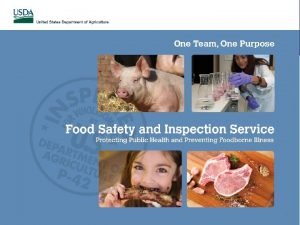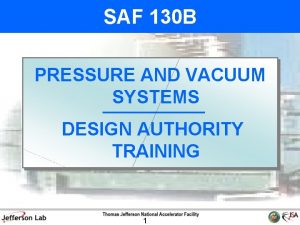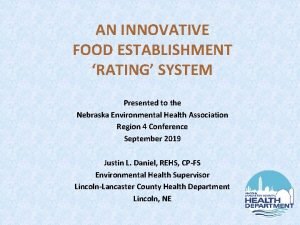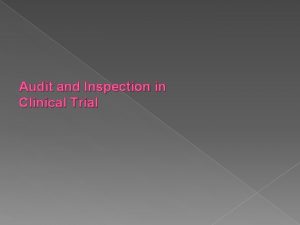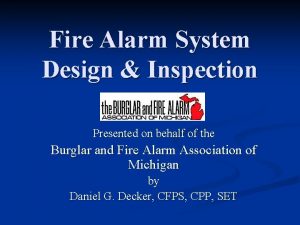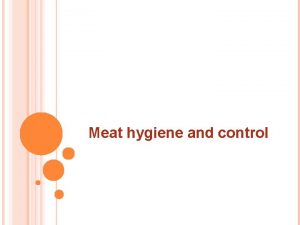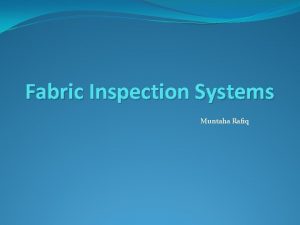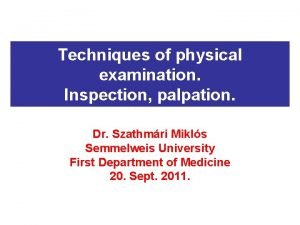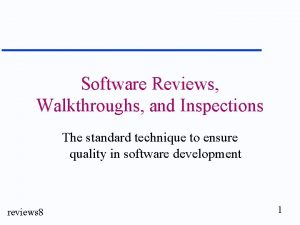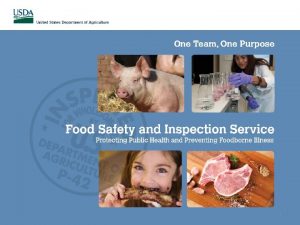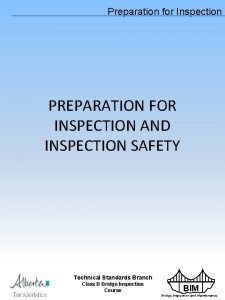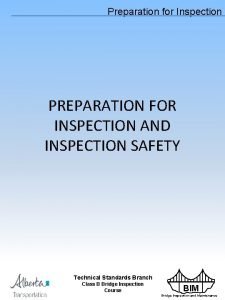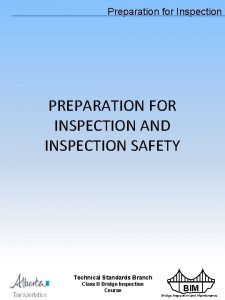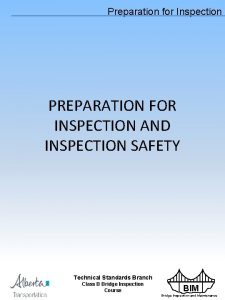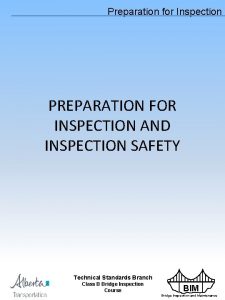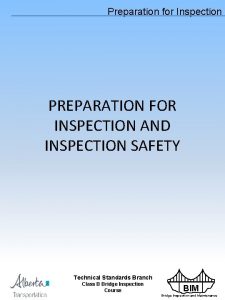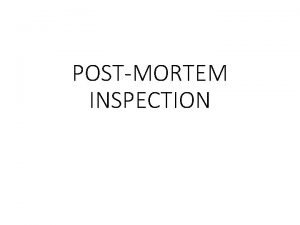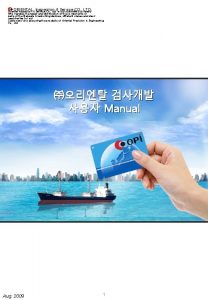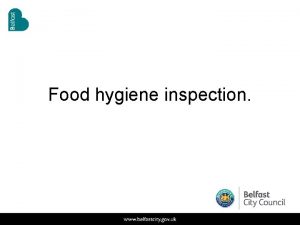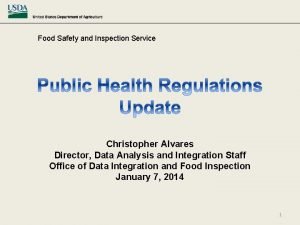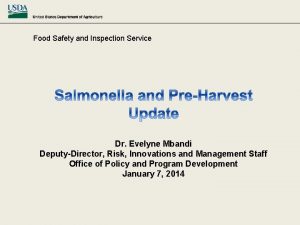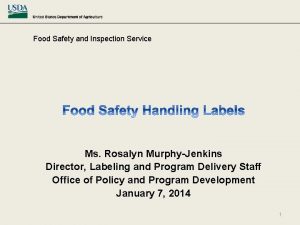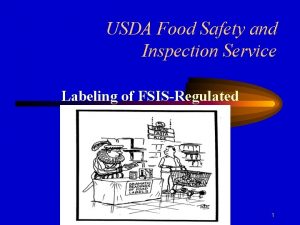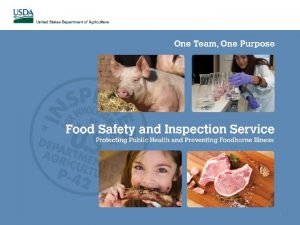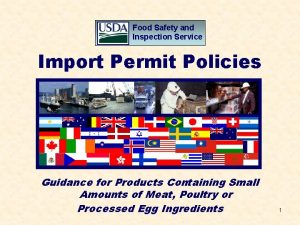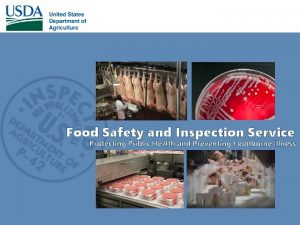Food Safety and Inspection Service 1 Food Safety



























- Slides: 27

Food Safety and Inspection Service: 1

Food Safety and Inspection Service: FSIS Labeling Jeff Canavan, Deputy Director Labeling and Program Delivery Staff, FSIS March 16, 2017 2

Food Safety and Inspection Service: Presentation Outline § § § Ingredient labeling Labeling of spices and flavorings Voluntary allergen statements Processing aids Release agents 3

Food Safety and Inspection Service: Ingredients Statement 9 CFR 317. 2(f) and 381. 118 require an ingredients statement when: • A product is fabricated from two or more ingredients – Declare all ingredients – By common or usual name – In descending order of predominance • Typically preceded by “Ingredients: ” (Note: exception for “cured with” statements on products such as bacon and ham) 4

Food Safety and Inspection Service: Exception to Descending Order of Predominance 9 CFR 317. 2(f)(1)(vi) and 381. 118(a)(2) • Ingredients in individual amounts of 2% or less may be listed in the ingredients statement in other than descending order of predominance • Such ingredients are listed at the end of the ingredients statement and preceded by a quantifying statement – Contains 2% or less of. . . – Less than 1. 5% percent of 5

Food Safety and Inspection Service: Exception to Descending Order of Predominance • Such a quantifying statement may also be used within a component’s sublisting, e. g. , “Ingredients: Beef, Bread Crumbs (wheat flour, water, contains 2% or less of …. . ), water, salt…” • Ingredients in the quantifying statement may be adjusted in the formulation without a change in the ingredients statement 6

Food Safety and Inspection Service: Common Ingredients Statement Problems • Order of predominance is incorrect • Order of predominance is not proven • Ingredients statement does not agree with formula (updated supplier inconsistent with labeling) • Failure to sublist ingredients 7

Food Safety and Inspection Service: Temporary Label Approval (9 CFR 412. 1(c)(4)) § A temporary label approval may be granted for labels with a deficiency that does not pose any potential health, safety or dietary problems to the consumer or provide a company an economic advantage (9 CFR 412. 1(f)(1)) § Temporary approvals typically do not to exceed 180 days, may be less and extensions can be granted on a case-by-case basis § Examples include: § § Incorrect legend on label (e. g. poultry legend on a meat label) Order of predominance of ingredients has changed Nutrition values not rounded in accordance with FSIS regulations Addition of sodium lactate and sodium diacetate 8

Food Safety and Inspection Service: Names of Ingredients • FDA products - 21 CFR 101. 4 Food; designation of ingredients, e. g. , – Dried whole eggs, frozen whole eggs, and liquid whole eggs may be declared as “Eggs” – “Whey, ” “Concentrated Whey, ” “Dried Whey, ” “Reconstituted Whey” may be declared as “Whey” • Acceptable, unless FDA regulation is contrary to our regulations or policy 9

Food Safety and Inspection Service: Names of Ingredients • Declared by their complete names – Sodium Nitrite – Dipotassium phosphate – Soy protein concentrate • Specific types of phosphates can be collectively designated as “sodium (or potassium) phosphates” • Corn syrup and corn syrup solids are synonymous 10

Food Safety and Inspection Service: Joint FDA and FSIS Ingredient Approval Process § Final rule published on December 23, 1999, “Food Ingredients and Sources of Radiation Listed or Approved for Use in the Production of Meat and Poultry Products” § Consolidated 9 CFR 318. 7 and 381. 147 into new table of approved substances in 9 CFR 424. 21 (c). Lists substance, general classification, permitted use levels, types of products § MOU signed in 2000 that outlined the procedures for how FSIS and FDA will work together to implement the ingredient approval process § For meat and poultry, FDA authorizes safety and FSIS determines suitability/efficacy of use § All ingredients approved since 2000 are listed in FSIS Directive 7120. 1 § Risk, Innovations, and Management Staff (RIMS) evaluates ingredients for FSIS, updates directive, and coordinates efforts with FDA 11

Food Safety and Inspection Service: Suitability in Meat and Poultry Products § Substance must be approved, “listed, ” or otherwise “no objection” by FDA § Proposed use must have a specific, technical purpose in the product/product category § Use must be limited to specific amounts or ranges, lowest level for intended effect § Use must not promote deception or mask spoilage indicators § Must be properly declared on the label unless determined to be a processing aid or incidental additive (21 CFR 101. 100 (a)(3)) § FSIS has the authority to make an independent evaluation of an additive with respect to use in meat, poultry, or egg products and restricts its use 12

Food Safety and Inspection Service: Spices • Defined in 9 CFR 317. 2(f)(1)(i)(A) and 381. 118(c)(1) – Cross reference FDA regulations in 21 CFR 182. 10 and 184 – Any aromatic vegetable substance in the whole, broken, or ground form – Primary function is to season – Except onions, garlic and celery 13

Food Safety and Inspection Service: Natural Flavors or Natural Flavorings • Defined in 9 CFR 317. 2(f)(1)(i)(B) and 381. 118(c)(2) – Cross reference FDA regulations in 21 CFR 172. 510, 182. 20, 182. 40, 182. 50 and 184 – Includes spices, powered onion, powdered garlic, and powdered celery – Essential oils, oleoresins, and spice extractives, e. g. , rosemary extract, citrus extract 14

Food Safety and Inspection Service: Spices and Flavoring Colorants • Spices or flavorings which are also colorants – Paprika, turmeric, saffron – Their essential oils, oleoresins, or extractives • Individually named or identified as “spice and colorant” or “flavoring and coloring” 15

Food Safety and Inspection Service: Cannot Be Identified as “Flavor” – Ingredients identified by usual name and source • Hydrolyzed (source) proteins – corn, casein, wheat gluten, wheat protein, milk protein, etc. • Hydrolyzed gelatin • Hydrolyzed (species and tissue of origin) • Autolyzed yeast extract • Monosodium glutamate 16

Food Safety and Inspection Service: Incidental Additives As defined by FDA • 21 CFR 101. 100(a) – Substances present in foods at insignificant levels – Substances do not serve a technical or functional effect in that food – Not necessary to declare within the ingredients statement – FSIS has ask. FSIS questions and compliance policy guide on incidental additives and processing aids that mirrors FDA’s regulation https: //askfsis. custhelp. com/app/answers/detail/a_id/1312/kw/NRTE 17

Food Safety and Inspection Service: Incidental Additive Examples • FD&C Red No. 3 used to color cure mixes • Gum Tragacanth is a carrier and stabilizer in liquid spice extractives – Not to exceed 0. 1% in finished product – Not permitted in sausage products • Anticaking agents in dry mixes (e. g. , sodium silicoaluminate, partially hydrogenated soybean oil, magnesium stearate) 18

Food Safety and Inspection Service: Incidental Additives - Carriers • Dextrose and/or sugar are commonly used as carriers for spice extracts and resins of spices – Undeclared when 0. 75% of the total product and when another sweetener is declared in ingredients statement • Salt used as a carrier for cure agent is not declared if salt from another source is declared 19

Food Safety and Inspection Service: Incidental Additives - New • Establishment’s responsibility to provide data – Amount of ingredient used in the formulation of the FDA food – Amount that is in the finished meat/poultry product – The level is so low that the intended effect is no longer active – The ingredient would not have an effect on the meat or poultry product • Establishment’s may use ask. FSIS as a mechanism to confirm whether or not a substance meets the definition of a processing aid or incidental additive 20

Food Safety and Inspection Service: Processing Aids: Proposed Use • Establishment’s responsibility to provide data to FSIS for caseby case determination: – Amount that is in the finished meat/poultry product – The level is so low that the intended effect is no longer active (e. g. , substance enzymatically degraded such as the use of lauric arginate on fresh meat) – The ingredient would not have an effect on the meat or poultry product (e. g. , antimicrobial agent does not suppress the growth of microorganisms) – No “self-determinations” by industry for processing aids in FSIS regulated products

Food Safety and Inspection Service: Processing Aids: Release Agents • Release agents used to prevent foods from sticking to food contact surfaces (e. g. , conveyor belts, cooking pans) or to aid in the release of elastic netting on cooked meat and poultry products – Sprays containing highly refined oils with propellants often used to prevent foods from sticking to food contact surfaces – Require labeling when contain allergens (e. g. , soy) as referenced in FSIS Directive 7230. 1 – No “self-determinations” by industry for processing aids in FSIS regulated products

Food Safety and Inspection Service: Voluntary Allergen Labeling Statements § § § The Food Allergen Labeling and Consumer Protection Act (FALCPA) did not amend FMIA, PPIA, EPIA FSIS supports voluntary use of allergen statements (e. g. “contains: soy”) Compliance policy guide on allergen statements posted on FSIS website https: //www. fsis. usda. gov/wps/portal/fsis/topics/regulatory -compliance/labeling/ingredients-guidance/allergensvoluntary-labeling-statements 23

Food Safety and Inspection Service: “May Contain” Statements: Federal Establishments § May be submitted for evaluation and approval in very limited situations where good manufacturing practices, and effective sanitation standard operating procedures (SSOPs) cannot reasonably eliminate the unintended presence of certain ingredients § § Chopped peanuts are used in making a dry Thai-style meat sauce mix, the necessity exists for a dry processing environment and, thus, the production equipment cannot be washed with water or other fluids. Peanut dust may become airborne and unavoidably contaminate other meat or poultry products manufactured in the same production area. In this situation, a statement about the manufacturing environment, as described above, or the use of a "may contain (name of allergenic ingredient)" statement may be used on meat and poultry product labeling. Not acceptable where it is used as a replacement for poor SSOPs, i. e. , failure to prevent cross-contact between production runs 24

Food Safety and Inspection Service: “May Contain” Statements: Purchased Products § “May contain” and “produced in a facility” statements on purchased products need to be carried through to the labeling of meat or poultry product except where the establishment: § § § Contacts the supplier and confirms in writing that the statement is a cautionary statement, and no such ingredient is in the product; and Includes a written statement in its hazard analysis to support why the “may contain” or “produced in a facility” statement is not carried forward to the finished meat or poultry product label Note: Carrying through statements of this type to the labeling of meat and poultry products in which the purchased components are used as ingredients is generically approved 25

Food Safety and Inspection Service: Websites Ingredient Frequently Asked Questions • https: //www. fsis. usda. gov/wps/portal/frameredirect? url=http: //www. fsis. usda. gov/OPPDE/larc/Ingredients/PMC_QA. htm Natural Flavors on Meat and poultry Labels • https: //www. fsis. usda. gov/wps/portal/fsis/topics/food-safety-education/get-answers/foodsafety-fact-sheets/food-labeling/natural-flavorings-on-meat-and-poultry-labels Food Additives • https: //www. fsis. usda. gov/wps/portal/fsis/topics/food-safety-education/get-answers/foodsafety-fact-sheets/food-labeling/additives-in-meat-and-poultry-products/additives-in-meatand-poultry-products Voluntary Labeling Statements – Allergens • https: //www. fsis. usda. gov/wps/portal/fsis/topics/regulatorycompliance/labeling/ingredients-guidance/allergens-voluntary-labelingstatements/allergens-voluntary-labeling-statements 26

Food Safety and Inspection Service: Questions? Contact LPDS Submit a Question to ask. FSIS Call: Labeling Procedures • http: //askfsis. custhelp. com • Questions are sent to a main portal, triaged, and assigned to the correct expert based on subject matter. • Main: 301. 504. 0878 • Distribution Unit: 301. 504. 0883 • Labeling_Procedures/index. asp • http: //www. fsis. usda. gov/Regulations_&_Policies
 Food safety and inspection service definition
Food safety and inspection service definition In service inspection
In service inspection Food establishment inspection viewer
Food establishment inspection viewer What is food safety
What is food safety Unit 2 food food food
Unit 2 food food food Food chain sequence
Food chain sequence Desired service and adequate service
Desired service and adequate service Evolution of soa
Evolution of soa Security survey inspection sample
Security survey inspection sample Difference between inspection and audit
Difference between inspection and audit 5988-e
5988-e Difference between inspection and audit
Difference between inspection and audit Isef eti
Isef eti Joint inspection of point and crossing
Joint inspection of point and crossing Audits and inspections of clinical trials
Audits and inspections of clinical trials Inspection and acceptance committee
Inspection and acceptance committee Regulation and inspection of social care wales
Regulation and inspection of social care wales Digital logbook maintenance and inspection
Digital logbook maintenance and inspection Lingula auscultation
Lingula auscultation Design and inspection of fire alarm system
Design and inspection of fire alarm system Kuok kim macau
Kuok kim macau Textile raw material
Textile raw material Meat hygeiene inspection
Meat hygeiene inspection Tools and tackle
Tools and tackle 4 point system fabric inspection
4 point system fabric inspection Physical exam abdomen
Physical exam abdomen Peer review walkthrough and inspection in software testing
Peer review walkthrough and inspection in software testing Difference between inspection and quality control
Difference between inspection and quality control
